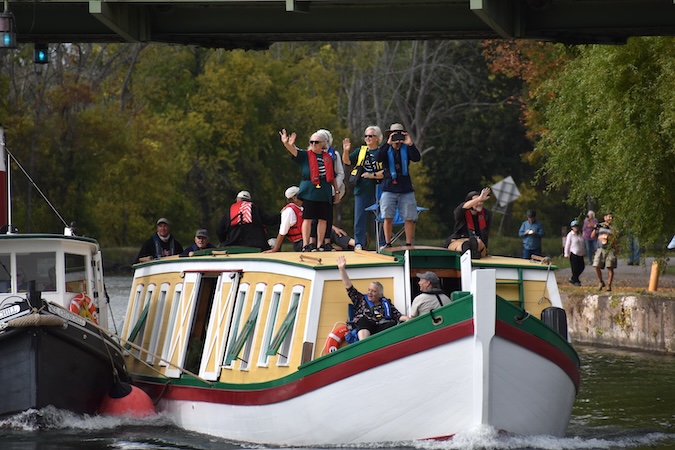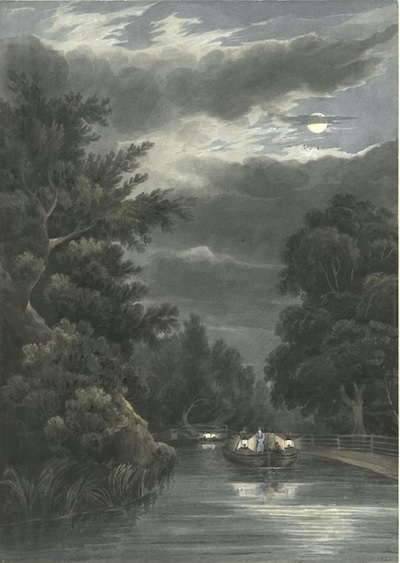Voyage of Seneca Chief replica boat harkens back to early days of Erie Canal

Photo by Tom Rivers: This group passes under the lift bridge in Eagle Harbor on Friday. They are aboard a replica of the Seneca Chief. This boat is 73 feet long and is making a commemorative journey along the canal in hoor the canal’s 200th anniversary. The boat was built as a replica of the original Seneca Chief that carried Gov. DeWitt Clinton on the maiden voyage on the completed canal in 1825.
By Catherine Cooper, Orleans County Historian
“Illuminating Orleans” – Volume 5, No. 34

“View on the Erie Canal” – The New York Public Library Digital Collections from 1832.
The commemorative journey of the Seneca Chief along the Erie Canal has attracted a great deal of attention. The boat left Buffalo on Wednesday and is on a 33-day tour that ends Oct. 26 in New York City.
On the original trip, the boat was hauled by “four fully caparisoned grey horses.” That would have been quite a sight! For this voyage, the horses have been replaced by a 33-foot-long tugboat, the C.L. Churchill.
We have mentioned the novel Rome Haul by Walter D. Edmonds in a previous column. It portrays a realistic view of life in the early years of the canal. The sight of the Seneca Chief brought this passage to mind. Here Dan Harrow remembers the opening of the canal and that first voyage:
“We’d talked about the canal. It didn’t seem it would ever get to us. They’d surveyed in ’19 (1819) and the route would come close to my place….Then, first thing we knowed, in ’23, men commenced working on the route between Black Rock and Lockport…..
“I remember, two springs after that, how me and Ellen sat on the big stoop in June. A warm afternoon. The word come the water would come in from Erie. And after a while we seen it come. Brown and muddy, very slow, so’s not to rip the banks. It went by us in a little creek. We watched it rise all day. At night it was still getting up. Brown and muddy. We didn’t have no supper. We didn’t want it. We’d listen to the water eddy down below all night. In the morning it had come off blue in the sun — pretty near that color.”
“Tolls was taken on the first of October. It had been a fine farming summer. I’d had more money in than I’d expected for a single year. Then on the twenty-sixth the opening come.”
“It was a masterful event. The leaves had turned late that year, and there was still color to the woods. “They had put cannon — you know how —all along the canal and down the Hudson. There was an old ten-pounder mounted on my rise of ground, its snout pointing west, and there was one of McDonough’s sailors there to touch it off.
“The neighbors came next morning early. Ellen and the women had gotten up a big feast. The men sat on the porch, looking down the canal to the lake. I had some Jamaica and Golden Medford for them — it was a brisk morning. Cool from frost at night, but no wind at all. The smoke from our pipes hung under the roof. The children played round — noisy. The cook smells came out to us.
“The sailor, Benjy Wright, sat on the cannon’s butt… About nine o’clock Benjy cut him a hard plug with his sailor knife. He lighted his match and we stood waiting. Then a cannon sounded down by Buffalo. And Benjy touched the match to the fuse and in a minute the old gun bucked and roared, and a glass broke in the window of the parlor….Then we sat down and watched Benjy load up the cannon. And an hour and forty minutes later there was a cannon faint to eastward of us. And our gun bucked and shot again and we heard a gun boom in Buffalo. But with that sound from the eastward of us we knowed that New York knowed. The sound of it told us that.
“All to once we knowed there was other people back east who knowed about us. We were in a country as big as half the world, but with that shot it all come closer together. We weren’t alone.
“For a while there was silence.
“Clinton’s boat come along a while later when we were eating dinner. The food got burnt somehow. But we cheered him by and his four grey matched horses, and he waved to us. And we cheered the other boats.
“But nights now me and my wife hear the boats once in a while —a horn, maybe — or, when it’s still, the clink of a trace chain. Or we see the night lanterns. The railroads come in time. But here it didn’t make so much difference.”
Rome Haul by Walter D. Edmonds in 1929 is available through your local library.




































































